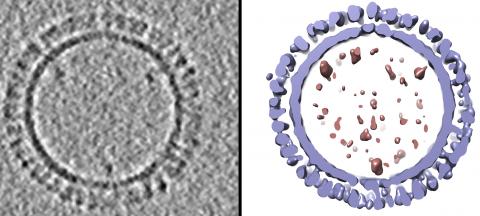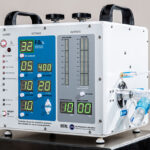
 The flu pandemic of 1918, also known as the Spanish flu, was the first of two flu pandemics involving the H1N1 virus. It affected approximately 500 million people worldwide, reaching even remote islands and the Arctic, and resulted in the deaths of somewhere between 50 and 100 million people, fully 3-5% of the world’s population at the time, making it the deadliest natural disaster in recorded history. As the flu wave spread around the world, wartime censors tried to minimize reporting on it so as to not adversely affect morale; however; countries such as Spain, which was neutral during WWII, freely reported on the disease. This gave the impression that the flu had hit Spain particularly hard, thus giving rise to the name Spanish flu, despite its heavy hitting consequences around the world.
The flu pandemic of 1918, also known as the Spanish flu, was the first of two flu pandemics involving the H1N1 virus. It affected approximately 500 million people worldwide, reaching even remote islands and the Arctic, and resulted in the deaths of somewhere between 50 and 100 million people, fully 3-5% of the world’s population at the time, making it the deadliest natural disaster in recorded history. As the flu wave spread around the world, wartime censors tried to minimize reporting on it so as to not adversely affect morale; however; countries such as Spain, which was neutral during WWII, freely reported on the disease. This gave the impression that the flu had hit Spain particularly hard, thus giving rise to the name Spanish flu, despite its heavy hitting consequences around the world.
This flu was particularly shocking not only because of its scale but because of the fact that rather than resulting in the deaths of the young, old, and sick as is normally the case during flu outbreaks, it killed primarily healthy young adults. There are a number of theories as to why this flu was so particularly deadly and samples of it that were preserved in the bodies of victims who were found frozen were subjected to study at the time in order to attempt to unravel its secrets. While some investigation has proposed that the virus itself was particularly aggressive, other research has suggested that rather than a difference in the virus itself, it was a change in global circumstances as a result of WWI, such as malnutrition and crowding in prison camps, that allowed the normal flu virus to wreak such deadly havoc. A recent theory suggests the possibility that aspirin poisoning contributed to the high number of deaths, as there was a distinct spike after the surgeon general recommended large doses of aspirin as treatment and in the wake of the expiration of Bayer’s patent on the drug in which a multitude of other companies rushed in to produce, and profit from, the production of aspirin.
Efforts to understand everything we can about such a deadly disease have not been shelved in the 100 years since its dramatic outbreak. New research being undertaken by scientists at the National Institute of Allergy and Infectious Diseases (NIAID), part of the National Institutes of Health, is working to better understand the H1N1 flu virus as part of a program to develop improved vaccine platforms using virus-like particles (VLPs). A virus-like particle is a protein-based structures that mimics a virus and binds to antibodies, with the important distinction of itself being non-infectious. This combination makes it the idea delivery platform for vaccines not only for the flu but potentially for diseases such as Ebola, SARS, and HIV.
In order to better understand how this might occur, an expert in 3D modeling was called in to create a rendition of the 1918 H1 pandemic influenza virus to help the researchers visualize the molecular structure. The data for the visualization was compiled through a process of collecting hundreds of VLP samples which were then quick frozen and sliced into layers, providing a view of their internal layers. Computers were used to track their key molecules and the the aggregate data was used to generate a full model of the molecular structure from the frozen samples.

While it has been possible to get close up imagery of the VLPs before, never has it been presented with the kind of clarity made possible using 3D modeling techniques. This has enabled the researchers to understand the unique arrangement of hemagglutinin (HA) proteins and it is believed that the number and location of HA molecules may influence the efficacy of VLP vaccines. The hope is that with this increased understanding they will not only be able to create a potential platform for vaccines against other diseases, but also more efficacious vaccines against the flu itself, even when it’s just the regular seasonal bug.
The results of their preliminary research have been published in Scientific Reports, and will no doubt encourage others to understand the value that 3D modeling holds for medical research on this micro level. “Structural analysis of influenza vaccine virus-like particles reveals a multicomponent organization” was authored by Dustin M. McCraw, John R. Gallagher, Udana Torian, Mallory L. Myers, Michael T. Conlon, Neetu M. Gulati, and Audray K. Harris.
What do you think of this news? Let us know your thoughts; join the discussion of this and other 3D printing topics at 3DPrintBoard.com.
[Source: NIAID]
If you're looking to request photorealistic CGI in the USA, our service offers an easy and efficient way to get stunning, lifelike renderings for your architectural and real estate projects. Through our platform, you can quickly request high-quality CGI images that accurately capture the essence of your designs. Whether it's for a residential or commercial property, our experts specialize in creating realistic 3D renderings that highlight every detail, bringing your vision to life with exceptional clarity and precision.
Through our website, requesting photorealistic CGI becomes a seamless experience. With our help, you can get highly detailed 3D visualizations that look just like photographs, providing a realistic representation of your project before it's even built. Our team ensures that every element, from textures to lighting, is meticulously rendered, giving you an impressive, lifelike result that will leave a lasting impact on your clients and stakeholders.






Leave a Reply
You must be logged in to post a comment.